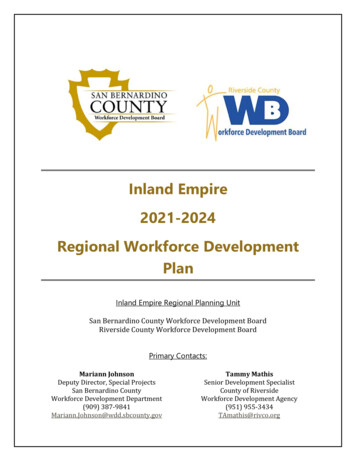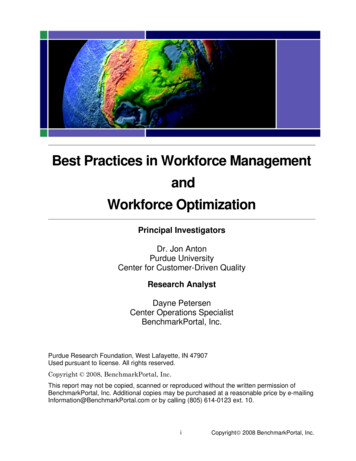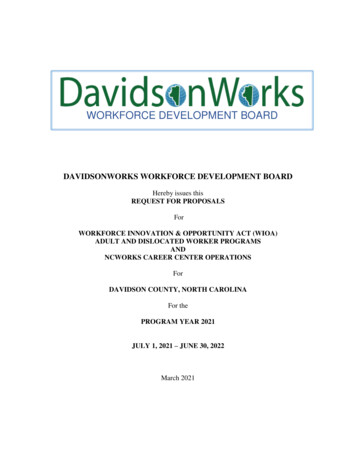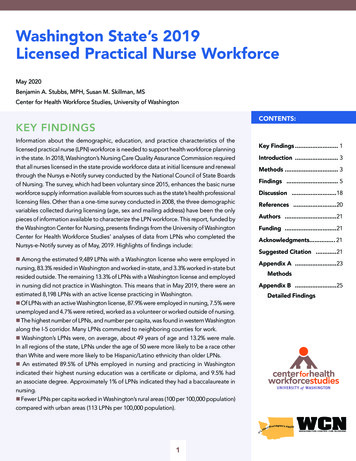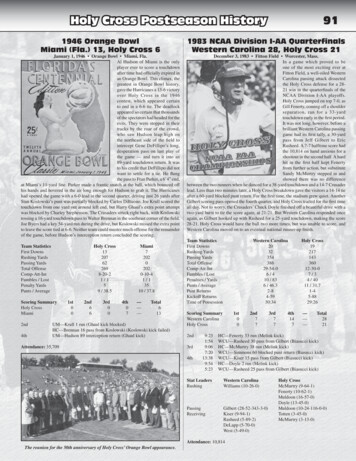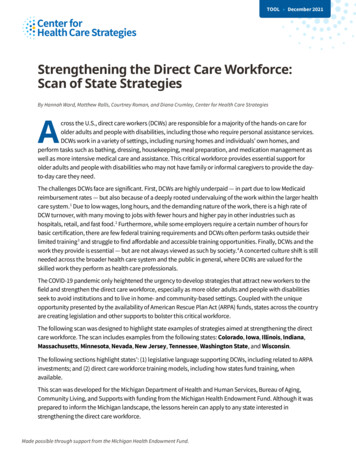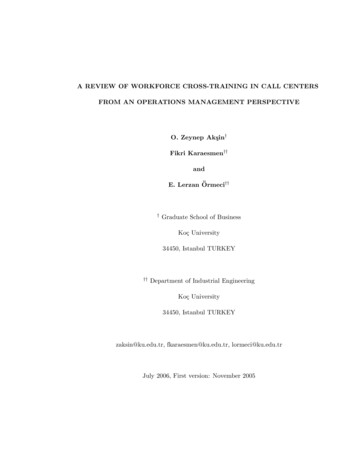
Transcription
A REVIEW OF WORKFORCE CROSS-TRAINING IN CALL CENTERSFROM AN OPERATIONS MANAGEMENT PERSPECTIVEO. Zeynep Akşin†Fikri Karaesmen††andE. Lerzan Örmeci†††Graduate School of BusinessKoç University34450, Istanbul TURKEY††Department of Industrial EngineeringKoç University34450, Istanbul TURKEYzaksin@ku.edu.tr, fkaraesmen@ku.edu.tr, lormeci@ku.edu.trJuly 2006, First version: November 2005
A REVIEW OF WORKFORCE CROSS-TRAINING IN CALL CENTERSFROM AN OPERATIONS MANAGEMENT PERSPECTIVEZeynep Akşin† , Fikri Karaesmen†† , and Lerzan Örmeci††† Graduate††1School of Business, Koç University, Istanbul, Turkey, zaksin@ku.edu.trDept. of Ind. Eng., Koç University, Istanbul, Turkey, fkaraesmen@ku.edu.tr, lormeci@ku.edu.trIntroductionCall centers, also known as telephone, customer service, technical support, or contact centers constitute a large industry worldwide, where the majority of customer-firm interactions take place.There are thousands of call centers in the world, with sizes in terms of full time employees rangingfrom a few to several thousand. Datamonitor estimates that the 2.5 million agent positions in theUnited States today will increase by more than 14% by 2005 (Datamonitor, 2002). Call centersin Europe, the Middle East and Africa (EMEA) are expected to swell to 45,000 by 2008, with 2.1million agent positions (Datamonitor, 2004).Modern call centers assume many different roles. While the telephone is the basic channel forcall centers, contact centers incorporate contacts with customers via fax, e-mail, chat, and otherweb-based possibilities. Agents in multi-channel contact centers have the possibility of respondingto customer requests via several different media (Armony and Maglaras, 2004a, 2004b). Inboundcall centers answer customer calls, whereas outbound centers make telephone calls to customersor potential customers typically for telemarketing or data collection purposes. Many call centerscombine these two features using what is known as call-blending, where agents that normally takeinbound calls perform outbound calls during times of low call volume (Bhulai and Koole, 2003;1
Gans and Zhou, 2003). As durable goods and technology companies globalize, technical supportneeds to be provided to customers that buy the same products around the globe. This support isgiven in several different languages in multi-language call centers located in hubs like Ireland, theBenelux countries and Eastern Europe. In these centers, agents that posess several technical skillsor speak several different languages respond to customer queries (Akşin and Karaesmen, 2002).Today, call centers in mature industries like financial services are in the process of transforminginto revenue or profit centers. To do this, these centers incorporate sales and cross-selling into theirprocesses, thus requiring agents to become experts in both service and sales (Akşin and Harker,1999; Güneş and Akşin, 2004). Many companies outsource their call center needs to third parties.An agent working in one of these outsourcing firms, may be responding to calls originating fromcustomers of different firms, all clients of the outsourcing company. Such agents need to possessknowhow for products, promotions or practices of different companies (Wallace and Whitt, 2004).Multi-channel contact centers, call-blending call centers, multi-language technical support centers,service and sales centers, and call center outsourcing are all examples of the growing diversity andcomplexity of call center jobs. Workforce cross-training has emerged as an important practice forcompanies that need to deal with this diversification in call center jobs.There is a delicate balance between quality and costs in the management of call centers. As adirect and important point of contact with customers, the call center needs to provide good callcontent and high accessibility. Call content quality hinges extensively on human resource practiceslike staff selection, training, and compensation, since it occurs at the point of interaction betweenagents and customers. High accessibility implies among other things that a calling customer willbe answered with a minimum wait. Determining the appropriate number of agents to have in thepresence of uncertain call volumes constitutes one of the most important challenges of call centermanagement, since adding staff implies adding costs for a call center. Indeed, 60-70% of call center2
costs are associated with staffing (Gans et al., 2003). The fact that better staffing practices arebecoming a competitive need is supported by the prediction that call center investment in workforceoptimization technologies will exceed 1 billion by 2006 (Datamonitor, 2005). To cope with thegrowing diversity of calls while keeping staffing costs to a minimum, a higher level of flexibility inanswering calls is required. Structures with multi-skill agents are becoming more prevalent, as thefollowing studies on multi-channel contact centers indicate: “78% of call centers surveyed by ICMIused agents skilled in both phone and non-phone transactions to handle inbound calls, 17% usedonly agents dedicated to the phone channel, and 5% said they used some multiskilled agents”(ICMI2002). “When handling transactions from multiple channels (both service level and response timeobjective transactions), just over half (52%) of call center managers participating in a recent ICMIWeb-based seminar said they use blended agent groups for the different channels as the workloadallows. Another 29% use separate agent groups for each channel, while 8% said they relied onmultimedia queues and multiskilled agents who handled whatever type of transaction was next inqueue” (ICMI, 2000). Technology provides skills-based routing capability, enabling the routingof calls to the agents with the appropriate skills, thus allowing call centers to reap the benefitsof flexibility. Through cross-training, call centers can increase the flexibility of their staff. IDCestimates revenue in the contact center training industry will grow from 415 million in 2001 tonearly 1 billion in 2006 (ICCM Weekly, 2002). Some of this growth will come from cross-training.This chapter will review the relatively young however growing literature on workforce crosstraining in call centers, making ties to related work in operations flexibility. In the subsequentsection, we discuss the costs and benefits of cross-training that have been analyzed in the literature. This section also illustrates the multi-disciplinary nature of the issue, on which we takea predominantly operational view. Section 3 establishes the importance of flexibility in call center operations. Viewing workforce cross-training from this flexibility lens, we identify three basic3
questions pertaining to the design and control problems, which are introduced in Section 2. Thefirst design problem is the skill set design, which we also label the scope decision. In terms ofcross-training, this refers to the questions: In which skills should servers be cross-trained? Howmany skills should they have? Literature related to this problem is presented in Section 3. Having decided on the scope, the next issue is to decide what proportion of the workforce should becross-trained. We label this design problem the scale decision and review related work on it at theend of Section 3. The design problems are closely related to the control problems of staffing androuting. Indeed, the value of different designs will interact with the subsequent staffing and routingdecisions. Papers that focus on the control part of the problem are reviewed in Section 4. We endthe chapter with a discussion of future directions in the last section.2Costs and Benefits of Call Center Cross-TrainingLike all human resource initiatives, there are benefits expected from cross-training practices. Theseare motivational benefits due to the enlargement or enrichment of jobs, cost benefits due to improvedcapacity utilization or improved speed, quality benefits including improved customer service. Thesebenefits come along with costs like training costs, loss of expertise and job efficiency, and mentaloverload. In this section, we review selected articles from the organizational behavior and operationsmanagement literatures that identify different costs and benefits of cross-training, and then interpretthese in the context of call centers.There is a vast literature in organizational behavior that explores the relationship between jobdesign and performance. Grebner et al. (2003) focus on this problem in the call center context.The authors provide examples of earlier studies supporting the argument that call center jobs arepredominantly specialized and simplified (Isic et al., 1999; Taylor et al., 2002), and as a resultrequire a relatively short period of training (Baumgartner et al. 2002). In their article, they4
empirically test the premise that this division of labor and simplification, while reducing personnelcosts, results in low variety-low job control which leads to lower well being and a higher intentionto quit among call center workers. The authors argue that call center jobs need to be redesignedin order to improve autonomy, variety, and complexity. In general, it has been argued that crosstraining improves job enlargement (variety) and job enrichment (autonomy), which in turn has apositive impact on performance (Hackman and Oldham, 1976; Ilgen and Hollenbeck, 1991; Xie andJohns, 1995). However, in Xie and Johns (1995), the authors demonstrate that there is a limiton the positive impact of job scope, and that beyond a threshold, job scope can become excessiveand induce stress which is dysfunctional for the organization. Thus we find that the motivationalbenefits one expects from cross-training in call centers can turn into costs if the resulting job scope istoo high. Combined with Grebner et al. (2003)’s argument, this suggests that from a motivationalstandpoint, moderate job scope is superior to no variety or excessive scope job designs. An empiricalinvestigation that determines the ideal region for job scope in different types of call centers remainsto be done.Campion and McClelland (1991, 1993) explore both the costs and benefits of job enlargement inservice jobs. Taking an interdisciplinary perspective, they summarize four different models of jobdesign coming from different disciplines: A motivational design that argues for job enlargement andenrichment; a mechanistic design recommending simplification and specialization; a biological modelthat advocates reduced pysical stress and strain; and a perceptual-motor model recommendingreduced attention and concentration requirements that lead to increased reliability. These modelsclearly point to some tradeoffs to be made between different benefits and costs involved. Theauthors identify the benefits of job enlargement as satisfaction (of individuals), mental underload,enhanced ability of catching errors, and improved customer service. The costs of job enlargement arestated to be higher mental overload, training requirements, higher basic skills requirements, more5
chance to make errors, decline in job efficiency, more compensable factors like education and skills(leading to higher compensation). Job enlargement is classified into two types: task enlargementwhich involves adding new tasks to the same job, and knowledge enlargement which refers to addingrequirements to the job that enhance understanding rules and procedures about other products ofthe organization. In their analysis, Campion and McClelland (1993) find that task enlargementmostly results in costs or negative benefits: more mental overload, greater chance of making errors,lower job efficiency, less satisfaction, less chance of catching errors, and worse customer service.On the other hand, knowledge enlargement is found to result in more satisfaction, less mentalunderload, greater chances of catching errors, better customer service, less mental overload, lesserchances of making errors, and higher efficiency.Reinterpreting in a call center context, we could say that task enlargement involves completingmore portions of a customer request. For example not just answering the initial part of a technicalquery, but completing the entire query, or not just attempting a sale but actually completingthe entire sales transaction could be seen as examples of task enlargement. On the other handanswering calls pertaining to different products, different languages, or different regions could beseen as examples of knowledge enlargement. Though the results remain to be tested in a call centersetting, the Campion McClelland results suggest that escalating calls to specialists in a technicalsupport center, or separating service and sales roles may be desirable in order to avoid enlargementcosts. Most call centers in the Evenson et al. (1999) study are reported to exhibit this type ofservice and sales separation, thus in a way providing a confirmation from practice. On the otherhand, cross-training that enhances flexibility through call-blending of inbound and outbound, ordeveloping an expertise in several products seems to be beneficial from a job design perspective.The organizational benefit derived from the flexibility of staff in the presence of uncertainty,is not considered in the job design literature. Taking a modeling perspective and focusing on call6
centers, Pinker and Shumsky (2000) ask the following question: ”Does cross-training workers allowa firm to achieve economies of scale when there is variability in the content of work, or does itcreate a workforce that performs many tasks with consistent mediocrity?”. The authors modelthe tradeoff between cost efficiency due to economies of scale resulting from cross-trained staff andquality benefits from experience-based learning in specialists. The authors find support for thewell known fact that a system with flexible servers can achieve the same throughput with fewerservers, however also demonstrate that higher flexibility results in lower quality and less customersatisfaction due to a decrease in experience in any given skill. This type of a quality deteriorationis also found to happen in a specialist system due to the possibility of low utilization, once againsacrificing experience related quality performance. The authors conclude that an ideal design willconsist of a mixture of specialized and flexible servers.In a general context, taking a predominantly operations management perspective, Hopp andVan Oyen (2004) develop a framework to assess the appropriateness of cross-trained workers indifferent manufacturing and service settings. Called agile workforce evaluation framework, thisframework identifies, by surveying an extensive literature, the links between cross-training andorganizational strategy, and superior architectures and worker coordination mechanisms for workforce agility implementations. The links to organizational strategy are classified in two groups,direct and indirect. The direct links are to cost in the form of labor cost reduction, time whichcaptures efficiency, quality, and variety. Improvements in motivation, retention, ergonomic factors,experience based learning, communication, and problem solving are the indirect links. Of these,variety is one which has not been directly considered in the job design literature. Based on thebrief review of the literature we have presented so far, we note that all of the direct and indirectlinks play a role in evaluating worker cross-training in call centers, emphasizing the importance ofthis practice for this industry.7
The Hopp and Van Oyen paper classifies workforce agility architectures in terms of skill patterns,worker coordination policies, and team structure. We provide examples of the first two features inthe context of call centers. Skill patterns relate to the questions that we refer to under the scopedecision mentioned in the introduction. It also resembles the task versus knowledge enlargement ofCampion and McClelland (1993). Skill patterns can be established taking skill types, entities (jobsor customers) or resources as a basis. In a call center setting, as mentioned by the authors, skilltypes can refer to calls pertaining to different products. Examples for entity based tasks are similarto those identified under task enlargement above. Resource based tasks could be for example crosstraining in a contact center in a way that servers are dedicated to particular channels (resources)however are cross-trained to do all tasks within a channel.Worker coordination policies determine how workers and tasks are matched over time. Callcenters allow for a wide range of worker coordination policies: fully cross-trained generalists whorespond to all types of queries all the time, partially cross-trained workers who can respond toqueries about more than one type of product but not all, cross-trained workers who answer thesame type of calls at certain times of the day (for example outbound calls after five, inbound before),cross-trained workers who help out different groups of specialists depending on system congestion(Örmeci, 2004), worker groups whose skill sets are nested such that calls are escalated from thesimplest level to more complex as the nature of the problem is explored (Shumsky and Pinker, 2003;Das, 2003; Hasija et al., 2005). It is also possible to come across systems where each server has itsown skill set and priorities defined over this set, such that calls are assigned to the next availableworker posessing the required skills at the appropriate priority level. This occurs in systems thatuse skills based routing to coordinate workers (Wallace and Whitt, 2004; Mazzuchi and Wallace,2004).The appropriateness of different design choices along the dimensions of skill pattern and worker8
coordination in different environments depends on training efficiency and switching efficiency (Hoppand Van Oyen, 2004). Of these, training efficiency is relevant for the skill pattern choice, andcaptures the ease with which workers can be trained in different skills. This factor covers similarcosts as those considered in the job enlargement context before. Switching efficiency refers to thecosts associated with changing tasks. These may be in the form of time lost between task changes,or in switching from one resource to another, or in terms of setup work that needs to be performedon each different entity (customer for example). Modern call center technology mitigates switchinginefficiencies to some extent. Computer telephony integration and automatic call dispatching allowservice representatives to view customer data and earlier history when calls need to be passedon. Since most call centers operate in a paperless environment, a physical switching time is nonexistent or minimal. Agents use the phone and their computers as the basic resource and this doesnot change from task to task. Since switching inefficiencies are relatively small, the main costs tobe considered in cross-training design for call centers seem to be those mentioned under trainingefficiency.Our review on the costs and benefits of cross-training suggests that apart from direct costslike the cost of training, compensation for additional skills, or quantifiable efficiency losses, costsassociated with cross-training are typically beyond the scope of operations management models.The latter often focus on the benefits of cross-training, particularly from a flexibility standpoint.The organizational behavior literature that focuses on job design seems to recommend moderatescope in cross-training. In Section 3 we review articles that explore the job scope question from aflexibility perspective, thus ignoring some of the human resource related issues analyzed in the jobdesign literature. Quality-efficiency tradeoffs modeled in Pinker and Shumsky (2000) imply thatgood designs mix specialized and flexible servers. Papers addressing the question of the appropriatemix of specialized and flexible servers are also reviewed in this section. Finally, we review related9
literature on worker coordination mechanism in call centers as problems of staffing and routing inSection 4.3Cross-Training and its Impacts on PerformanceThis section focuses on the performance improvements brought about by cross-training. In Section3.1, the cross-training issue is related to the framework of operational resource flexibility, and therelated literature is reviewed. Section 3.2 outlines some of the general guidelines for the scope ofcross-training suggested by the operational flexibility literature. Finally, Section 3.3 focuses onthe issue of scale of cross-training. This section introduces and discusses the general principlesbut postpones a number of critical operational issues such as staffing and routing in a call centercontext to Section 4.3.1Cross-Training and Operational Flexibility LiteratureIn this section we present the impacts of cross-training structures on the performance of a call centerfocusing on operational issues. As already mentioned in Section 2, our discussion focuses on thebenefits in terms of resource flexibility. In a survey article focusing on manufacturing applications,Sethi and Sethi (1990) describe several different dimensions of flexibility. Our discussion will bebased on a particular type of flexibility most closely related to cross-training. Resource flexibilitywill be understood as the capability of a resource to perform several different tasks.In the operations literature, resource flexibility has been studied extensively. A typical problemin that setting is to evaluate the performance of the system, such as a flexible manufacturing system,under a particular type of resource flexibility structure (see Sethi and Sethi, 1990). More recently,a number of papers have addressed operational issues in the presence of flexible resources. Arelatively well-studied problem from that perspective is that of capacity investment. These papers10
assume a certain form of flexibility and then explore the question of the ideal level of this flexibilityand how it relates to value in terms of throughput or revenues under uncertain demand (see forexample, Fine and Freund (1990) Netessine et al. (2002)). Van Mieghem (1998) provides a reviewof the literature on this problem.Our focus as the main design issue in this section is cross-training or flexibility structure. Thereis a rich operations literature on this problem. Starting with the influential work of Jordan andGraves (1995), this stream of work keeps all other design parameters fixed and investigates theisolated effects of varying the flexibility structure. Motivated by an automative sector example,Jordan and Graves (1995) explore the problem of assigning multiple products to multiple plants.The demand for each product is random and the flexibility of the plants determines which productsthey can handle. Jordan and Graves develop general guidelines for this problem. One of theirimportant findings is that well-designed limited flexibility is almost as good as full flexibility. Wediscuss some of these general guidelines in Section 3.2.While the general flexibility principles of Jordan and Graves were established for a particularmodel, a number of subsequent papers have observed that these principles are robust to the assumptions of the particular model. For instance, the model of Jordan and Graves is a single-periodmodel that ignores the dynamics of the system. Sheikzadeh et al. (1998) consider a flexible manufacturing system modeled by parallel queues and observe that the general flexibility principles holdin this case. Gurumurthi and Benjaafar (2004) also present a numerical investigation of the benefitsof flexibility based on a queueing model. Jordan et al. (2004) also consider a queueing-based modeland confirm and extend some of the general principles.Another interesting observation is that even though the model in Jordan and Graves (1995)is a parallel resource type system, most general principles also hold for serial systems such asproduction lines or assembly lines. Graves and Tomlin (2003) perform a similar analysis for a11
multi-stage version of the system in Jordan and Graves, and develop a flexibility measure for suchsystems. Hopp et al. (2004) explore the benefits of chaining in the context of cross-training forproduction lines. Inman et al. (2004) investigate different cross-training structures for workers inan assembly line.Despite the existing flexibility principles, it remains difficult to say whether one particularflexibility structure is better than the other in terms of operational performance when cross-trainingcosts are disregarded. An interesting recent development has been the work of Iravani et al. (2005)who develop a structural flexibility index that quantifies the structural flexibility in production andservice systems, and allows a ranking based on performance of these systems. Numerical resultsconfirm that the index is quite accurate for comparing system performance.3.2General Flexibility GuidelinesLet us go through an example in detail to demonstrate the impacts of different cross-trainingstructures. Let us assume that there are three different types of calls A, B, and C each onecorresponding to a particular skill. Let us also assume that the call center is organized in threedepartments corresponding to the main skills demanded (A,B, or C). Figure 1 depicts a sampleof eight different cross-training structures. In this figure, for each structure, the nodes on the leftrepresent the different call types, and the nodes on the right represent resources (servers) and theirskills. Structure 1 in Figure 1 depicts a system where there is no cross-training and each group ofservers can respond to a single type of call. While this system has obvious advantages in terms ofhiring and training costs, it also has an important disadvantage. Since calls arrive randomly overtime, it may be possible that one of the departments is completely busy while in another one theremay be idle servers. This causes customer service levels to fall even though capacity (i.e. totalnumber of servers) is sufficient.12
C,B5C43A,BAABB,A,CB,ACCBC,AC,B67AAB,ABC,AC8Figure 1: Different Cross-Training StructuresLet us now assume that the servers whose main skills are A are also trained in skill C, thosewhose main skills are B are trained in A, and those whose main skills are C are trained in B.The resulting structure is depicted as structure 2 in Figure 1. We can view this new structureas consisting of three service departments A, B and C distinguished by their main skills. In thiscase, if department A is busy, arriving type A calls can be answered by cross-trained servers indepartment B (if they are available). Similar assignments may also take place for calls of type Band C.Structure 3 in Figure 1 represents the case of completely multi-skilled servers who are all ableto respond to all three types of calls. In this structure, all servers are cross-trained to have all thethree skills. As can be seen in the figure, in this structure, the notion of different departments losesits significance. In a way, there is a single multi-skilled pool of servers who do not differentiatebetween different types of calls. The system is as efficient as it gets in terms of customer serviceperformance. In this structure, a customer can only wait because all servers are busy but notbecause of a mismatch between demand type and the skill-set of a server available. This is however13
at the expense of increased cross-training costs and possibly higher burnout rates for servers dueto increased task complexity.The problem of designing the right cross-training structure now appears clearly. The systemwith dedicated departments in Structure 1 of Figure 1 is cost effective in terms of cross-trainingrequirements but may suffer in customer performance, whereas the Structure 3 of the same figure isat the opposite extreme. Is there a cross-training structure somewhere in between the two extremesthat is satisfactory in terms of customer service performance but not too costly in terms of crosstraining expenses? In other words, what is the right scope of resource flexibility? The answer tothis question in a given situation depends on a number of complicated aspects of the problem suchas customer service performance objectives, the capacities of departments, the difficulty and thecosts associated with cross-training the servers, and the operational costs of using cross-trainingeffectively (i.e. by correctly routing the calls). On the other hand, there are certain generalproperties which provide a guideline to these issues. Starting with the work of Jordan and Graves(1995), this question has received a lot of attention. Below, we outline some of the general principlesconcerning cross-training structure.We begin with a basic property, motivated by a comparison between two systems where oneof them has additional cross-trained servers. An example would be a comparison of Structures 1,5 and 2 in Figure 1. If we leave aside problems of call routing, answer quality and call duration,clearly the performance of structure 5 is at least as good as that of Structure 1 but cannot be betterthan the performance of structure 2. In fact additional cross-training can be seen as a possible callassignment option which cannot degrade performance.Property 1 Increased cross-training increases (in a non-strict sense) customer service performance.Despite its simplicity and generality, Property 1 is of limited use for cross-training design since14
AA,DAA,BBB,ABB,ACC,BCC,DDD,CDD,C109Figure 2: Two different structures: two chains versus a single chainit does not enable us to make a useful statement on how much cross-training is required given thatcross-training is costly. In order to obta
A REVIEW OF WORKFORCE CROSS-TRAINING IN CALL CENTERS FROM AN OPERATIONS MANAGEMENT PERSPECTIVE Zeynep Ak siny, Fikri Karaesmenyy, and Lerzan Ormeci yy yGraduate School of Business, Ko c University, Istanbul, Turkey, zaksin@ku.edu.tr yy Dept. of Ind. Eng., Ko c University, Istanbul, Turkey, fkaraesmen@ku.edu.tr, lormeci@ku.edu.tr 1 Introduction Call centers, also known as telephone .



